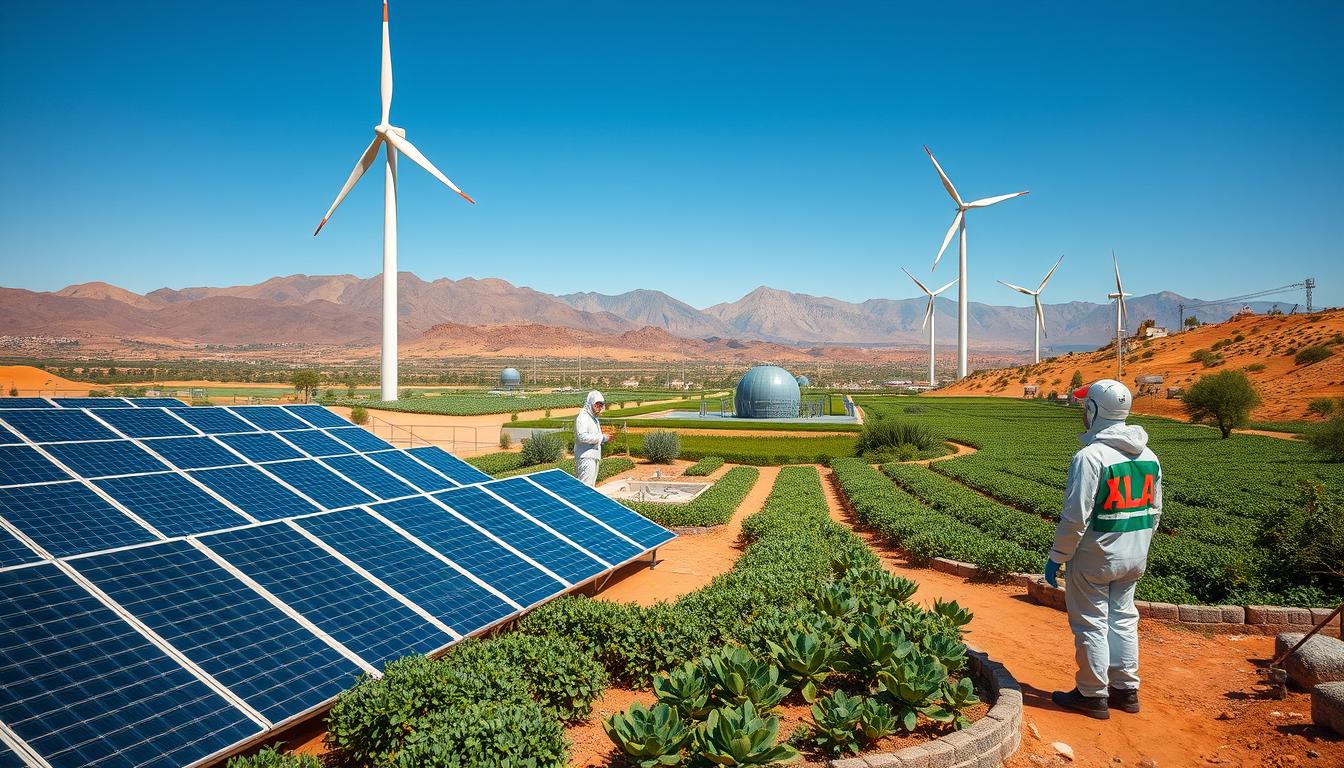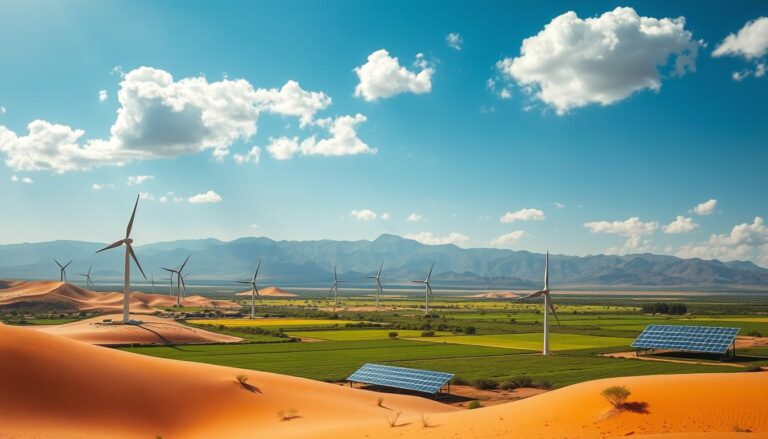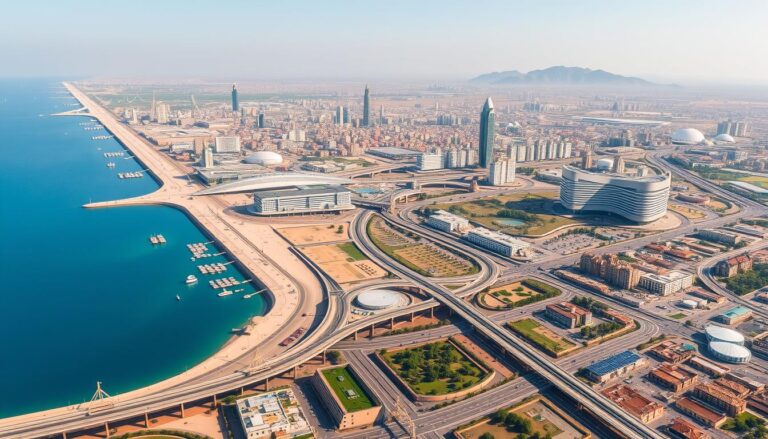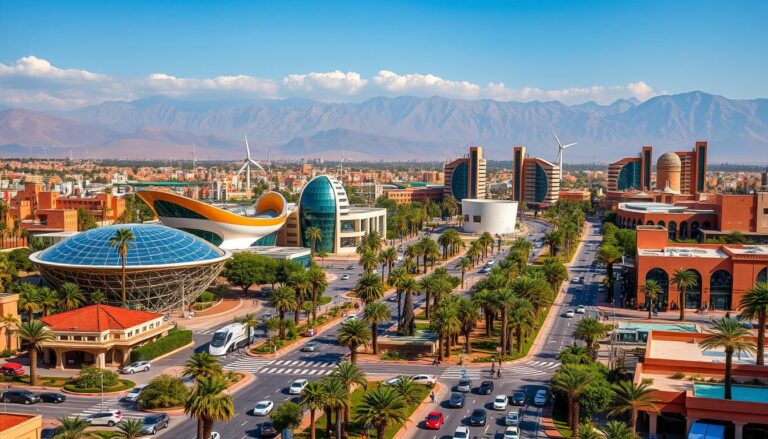Imagine Morocco, famous for its vast deserts and historic cities, becoming a leader in green hydrogen energy. This country is making a big push towards sustainable energy development. It aims to lead the green hydrogen revolution and change its clean energy landscape. Morocco wants to help meet global climate goals.
With its strategic location and big plans for renewable energy, Morocco’s future in hydrogen energy looks bright. It plans to use its lots of solar and wind power. This will help Morocco become more energy independent.
Morocco needs about $76 billion from 2020 to 2050 to grow its green hydrogen industry. But, there are big challenges ahead. Water is scarce, and most of it goes to farming.
Despite these problems, Morocco has made important deals with the European Union. These deals could help it start exporting green hydrogen in the future.
Projects like an 8 gigawatt green hydrogen plant in Dakhla show Morocco’s dedication to this technology.
The Emergence of Green Hydrogen
Morocco is making big strides in hydrogen energy technology. It’s investing in green hydrogen to change its energy scene. This move is key to its goal of using more renewable energy sources. Green hydrogen is a clean, zero-emission fuel that helps fight climate change.
What is Green Hydrogen?
Green hydrogen is made by splitting water into hydrogen and oxygen. This process uses renewable energy like wind and solar. It’s a clean fuel with no carbon emissions, unlike traditional hydrogen made from natural gas.
Production Methods and Benefits
There are two main ways to make green hydrogen:
- Electrolysis: This method uses renewable energy to split water into hydrogen and oxygen. It’s key for making clean hydrogen without pollution.
- Biomass Gasification: This process turns organic materials into hydrogen and other products. It’s another way to make green hydrogen, alongside electrolysis.
Green hydrogen has many benefits:
- Environmental Impact: It produces no emissions, which is good for the climate and air quality.
- Energy Security: Green hydrogen can be used in many areas, like transportation and industry. This boosts energy independence.
- Economic Growth: Morocco aims to create over 15,000 jobs by 2030 thanks to green hydrogen. This is driven by local and export demand.
Morocco wants to get 52% of its electricity from renewables by 2030. It’s investing heavily, like Total Energies’ €9.4 billion project. This will help Morocco become a big player in the global green hydrogen market. The goal is to meet the expected demand of 600 TWh by 2030.
Morocco’s Renewable Energy Landscape
Morocco has made big steps in renewable energy, focusing on solar and wind projects. This effort is part of a bigger plan to add green hydrogen to the energy mix.
Solar and Wind Energy Projects
The Noor Ouarzazate Solar Complex is a key example of Morocco’s renewable energy drive. It’s one of the biggest solar power plants worldwide. The Tarfaya Wind Farm, Africa’s largest, shows Morocco’s commitment to wind energy.
These projects show Morocco’s dedication to sustainable energy. They also support green hydrogen initiatives.
Key Infrastructure Developments
Morocco’s progress goes beyond solar and wind projects. It’s also building infrastructure for green hydrogen. One million hectares of public land have been set aside for this, starting with 300,000 hectares.
This move shows Morocco’s plan to cover the green hydrogen value chain. It includes everything from electricity generation to making synthetic fuels.
The Moroccan Government is building top-notch infrastructure. This makes Morocco a key player in green hydrogen production. It also helps reduce greenhouse gas emissions and fight climate change.
Strategic Geographic Advantage
Morocco is in a great spot, close to Europe. This makes it a key player in the green hydrogen market. It’s using its renewable energy to draw in big investments.
Proximity to Europe
Morocco’s location is a big plus because it’s near Europe. This makes it a top supplier for Europe’s green hydrogen needs. The Morocco-Europe pipeline is making good progress.
European leaders see Morocco as key for green hydrogen. They value its renewable energy and strategic spot.
Investment Attraction
Morocco is drawing in investors for green hydrogen projects. About 100 investors are interested. The goal is for 52% of energy to come from renewables by 2030.
300,000 hectares are set aside for green hydrogen projects. Morocco wants to meet a big demand for green hydrogen by 2030 and 2050. It needs $760 billion for the needed infrastructure.
Morocco plans to use at least 7GW of renewable energy by 2030. It’s not just solar and wind. Its long coastline also offers marine renewable energy. This will help in sustainable development and cut oil imports.
Policy Framework and Government Support
The Moroccan government is key to the country’s growing green hydrogen sector. It has a solid policy and offers incentives. This helps Morocco become a leader in renewable energy.
Government Initiatives
The government has set aside about one million hectares for green hydrogen. This starts with 300,000 hectares in plots of 10,000 to 30,000 hectares. A careful investor selection process checks each project.
Studies are underway to grow port capacities. This will help trade green hydrogen and boost Morocco’s partnerships.
Incentives and Subsidies
There are many incentives and subsidies for green hydrogen investment. These include tax breaks, grants, and easier rules. The National Office of Electricity and Water is improving the grid.
Water management is also a focus, with more desalination facilities. The government has a plan called the
Morocco Offer
. It shows the government’s strong support for hydrogen development.
Technological Innovations and Collaborations
Morocco is leading the green hydrogen revolution. It’s thanks to the country’s focus on new hydrogen technology. Morocco wants to use its renewable energy to make up to 1 million tonnes of green hydrogen by 2030.
Global Partnerships
Morocco is making global hydrogen technology partnerships a big part of its strategy. It’s working with groups like the European Bank for Reconstruction and Development (EBRD) and the International Finance Corporation (IFC). These partnerships bring in money and help share knowledge and technology.
For example, Morocco and the Netherlands have started a $300 million fund. It’s for projects in water and renewable energy, like green hydrogen.
Electrolysis Process Development
Improving the electrolysis efficiency is key to making green hydrogen. Morocco is working with experts from around the world to make the process better. They want to make it cheaper and more efficient.
By doing this, Morocco hopes to cut down on carbon emissions. It also wants to increase its use of renewable energy to 80% by 2050.
Investment Opportunities in Green Hydrogen
The green hydrogen sector in Morocco is growing fast. It offers many investment opportunities. Morocco aims to lead in green hydrogen production by expanding its renewable energy.
Several factors support Morocco’s green hydrogen investment:
- The country aims to invest $10 billion in green hydrogen, for both local use and exports.
- It plans to increase renewable energy to 52% of power by 2030, and 80% by 2050.
- It has a partnership with the European Union to share energy goals.
Electrolysis plants are key in this sector. They turn renewable energy into hydrogen. Morocco’s existing pipeline infrastructure also boosts its appeal for investors.
Investors are drawn to Morocco’s stable energy policies and government support. Projects like the Noor Solar Project and incentives for renewables make it a safe place for investment.
“North Africa’s potential for green hydrogen is immense, driven by abundant solar and wind resources and supportive infrastructure,” said an industry expert.
In summary, Morocco’s location, strong policies, and government plans make it a great place for green hydrogen investment.
Challenges and the Path Forward
Morocco is on a journey to build a strong green hydrogen economy. But, it faces big challenges like high production costs and the need for more infrastructure. The government is working hard to solve these problems and build a sustainable energy system.
Overcoming High Production Costs
High production costs are a big hurdle for hydrogen. Morocco removed subsidies on gasoline and diesel in 2014 and 2015. This move helped free up money for renewable energy.
But, hydrogen production is still very expensive. It’s estimated that up to USD 198 billion will be needed from 2020 to 2050 for decarbonization. Investing in new technology and strategies can help lower these costs.
Infrastructure Development Needs
Building a sustainable energy system requires a lot of work and changes. By 2020, Morocco had 37% of its energy from renewables. But, it aims to reach 52% by 2030, which means more infrastructure is needed.
International partnerships are key in this area. For example, the Germany-Morocco Hydrogen Agreement will help build a hydrogen plant in Morocco. This shows how working together can help grow and sustain infrastructure.
Morocco is making progress toward a green hydrogen economy. It must tackle production costs and build more sustainable energy infrastructure. With help from other countries and strong policies, Morocco is becoming a leader in green hydrogen.
Future of Hydrogen Energy in Morocco
Morocco is making a big impact in the *hydrogen economy in North Africa*. This is thanks to strong support from the European Investment Bank (EIB). Since 1979, the EIB has worked with Morocco on many projects, including energy. They help with money and know-how, focusing on projects that are good for the planet and the economy.
One key project is Morocco’s work with the EIB. This partnership has been successful in other areas, like the Nour Ouarzazate solar complex. Morocco is well-positioned to grow its hydrogen production thanks to these experiences. Studies funded by the EIB show Morocco could meet up to 4% of global green hydrogen demand by 2030.
“Morocco’s favorable conditions for hydrogen production, including its renewable energy potential, developed infrastructure, and mature strategic vision, make it a promising player in the hydrogen economy in North Africa.”
Morocco is also investing in solar energy, with a USD 9 billion plan to generate 2 gigawatts of power. This plan fits well with its hydrogen goals. It helps Morocco become more energy independent and important in the global hydrogen market.
The EIB also helps Morocco in other ways, like improving sustainability and competitiveness in hydrogen. They use money and expertise to make sure projects are good for the economy, environment, and society. They check projects carefully to meet high standards.
Despite challenges like high costs and managing resources, Morocco is still working hard to cut greenhouse gas emissions. It aims to reduce emissions by 42% by 2030. Morocco’s plan to use hydrogen at home and for exports shows its ambition and forward thinking. This makes it a key player in the hydrogen economy in North Africa.
Morocco’s Role in the Global Green Hydrogen Market
The world is shifting towards clean energy solutions, and Morocco is at the forefront. The country is investing heavily in renewable energy. This makes it a major player in exporting green energy, especially to Europe.
Projects like the Noor Ouarzazate Solar Complex and the Tarfaya Wind Farm show Morocco’s big plans. They highlight the country’s role in the growing green hydrogen sector.
Export Potential
Morocco’s renewable energy strategy is very promising. Its location near Europe makes it a great exporter of green energy. The country’s solar and wind power add to its green hydrogen production.
The government is making it easier for investors to come in. This boosts Morocco’s export potential and makes it more attractive to investors worldwide.
International Market Position
Morocco wants to meet over 4% of global green hydrogen demand by 2030. This shows its strong position in the market. The country has set aside 1 million hectares for green hydrogen projects.
Morocco has the right infrastructure for green hydrogen production. It has high-performance ports and a strong electricity network. Working with global leaders in hydrogen technology also helps Morocco stand out.
The “Morocco Offer” is a comprehensive plan for green hydrogen. It covers everything from production to export. This plan makes Morocco a key player in global green hydrogen initiatives. It’s a big step towards sustainable energy worldwide.
The Environmental and Economic Impact
Morocco is leading the way with its green hydrogen initiative. This move is set to change its environmental and economic landscape. By using green hydrogen, Morocco is tackling its national goals and helping the world fight climate change.
Projects like the Noor Ouarzazate Solar Complex and the Tarfaya Wind Farm show Morocco’s dedication to renewable energy. These efforts lay a strong base for the green hydrogen industry.
Environmental Benefits
Green hydrogen is a game-changer for the environment. It cuts down on carbon emissions, helping to fight climate change. Morocco’s push for green hydrogen is in line with global efforts, like those of Saudi Arabia and the UAE.
Together, these countries aim to reduce their use of fossil fuels. This highlights the key role of green hydrogen in achieving a cleaner, more sustainable world.
Economic Growth and Job Creation
The green hydrogen sector also brings big economic benefits. Morocco’s government sees green hydrogen as a key part of its energy strategy. This focus is expected to boost the economy.
New industries and jobs will come from renewable energy and electrolysis plants. Morocco’s work with global leaders could make it a big player in exporting green hydrogen. This could open up new investment areas, making Morocco’s economy more diverse and strong.
Green hydrogen projects offer a win-win situation. They help protect the environment and boost the economy at the same time.
Conclusion
Morocco is moving forward with green hydrogen, showing its dedication to sustainable energy and economic growth. Its climate and location make it a key player in green hydrogen production. Working with top companies and research groups will boost local businesses.
Investing in training and solving infrastructure issues will help Morocco grow in sustainable energy. The urgent need for green solutions and the EU’s green hydrogen goals highlight Morocco’s chance. Strengthening ties with the EU will make Morocco a trusted partner in green hydrogen.
Morocco is on track to become a model for sustainable energy. With teamwork, government support, and smart investments, it can lead the way to a greener future. This will benefit not just Morocco but the whole world.
Source Links
- Green Hydrogen market in Morocco: needs and barriers
- A Critical Analysis of Morocco’s Green Hydrogen Roadmap: A Modelling Approach to Assess Country Readiness from the Energy Trilemma Perspective
- Providing climate-friendly energy
- Morocco
- Morocco’s emergence as a green hydrogen leader – African Association of Entrepreneurs
- Morocco’s Strategic Move in the Green Hydrogen Sector: Unveiling the "Morocco Offer"Article
- Morocco’s Energy Transition: Prioritizing Natural Gas, Embracing Green Hydrogen, and Global Collaboration at COP28
- Morocco’s Revolutionary Green Hydrogen Offer – CASCI
- Morocco to Dedicate One Million Hectares for Green Hydrogen Projects
- Marine Renewable-Driven Green Hydrogen Production toward a Sustainable Solution and a Low-Carbon Future in Morocco
- Morocco – Energy
- Morocco’s Energy: Legal Framework & Investment Insights
- Morocco’s green hydrogen offer and opportunities for investors
- Unleashing Morocco’s Potential: The Blue Economy And Green Hydrogen – OpEd
- Morocco’s path to a climate-resilient energy transition: identifying emission drivers, proposing solutions, and addressing barriers
- Realizing North Africa’s green hydrogen potential
- Financing Green Hydrogen Projects in Morocco and Chile – REGlobal – Finance
- Green hydrogen economy – predicted development of tomorrow
- Morocco’s Future Energy: The Path Forward | ISPI
- Green hydrogen from Morocco – no magic bullet for Europe’s climate neutrality | Heinrich Böll Stiftung | Brussels office – European Union
- Geopolitics of the Energy Transformation: The Hydrogen Factor
- The EIB and the Future of Green Hydrogen in Morocco: Interview with Adrien de Bassompierre
- Pathway – Mission Innovation
- Morocco and the Future of Green Hydrogen
- MASEN – Offre Maroc Hydrogène Vert
- Just Energy Transitions? Lessons From Oman and Morocco
- How Can Moroccan SMEs Participate in the Green Hydrogen Revolution?
- Hydrogen: Fueling EU-Morocco Energy Cooperation? – Middle East Policy Council

The Editorial Team is a passionate group of Morocco enthusiasts dedicated to sharing the beauty, culture, and wonders of this captivating country. With diverse backgrounds and a deep love for travel, we strive to bring you engaging and informative content that inspires your Moroccan adventures. From uncovering hidden gems and sharing local insights to exploring mouthwatering cuisine and showcasing the vibrant lifestyle, our team is committed to providing you with valuable resources and exciting stories that enhance your exploration of Morocco. Join us on this journey as we celebrate the rich heritage and unforgettable experiences that make Morocco truly special.






